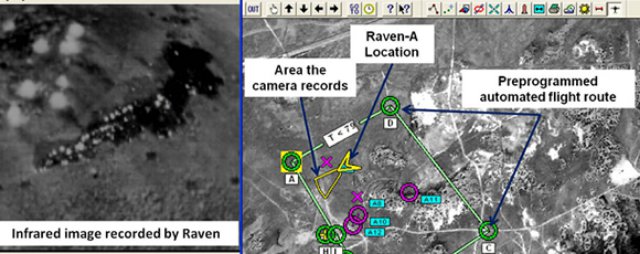 In 2008, the US Geological Survey (USGS) at the Rocky Mountain Geographic Science Center recognized the potential for sUAS use in scientific monitoring and study. Of particular note was the need to enter active volcanoes to collect information without risking humans in helicopters.
In 2008, the US Geological Survey (USGS) at the Rocky Mountain Geographic Science Center recognized the potential for sUAS use in scientific monitoring and study. Of particular note was the need to enter active volcanoes to collect information without risking humans in helicopters.
In the fall 2009 flight training at the Dugway Proving Ground, Utah, Department of Defense fire-fighters lit a prescription burn in range land near the Raven flight training area. Student pilots were able to fly close observation with visual and infrared cameras to document hot spots, vehicles, people igniting fires and wild horses and pronghorn antelope in the area.
The Raven was able to operate in smoke, rain, snow and night-time limited visibility environments where operation of a manned helicopter or fixed wing aircraft would have involved significant risk. Pilots were able to manoeuvre into relatively close proximity of wildlife and persons on the ground to observe and record their actions without detection.
The Raven A was designed for wartime missions to provide a lightweight (4.5 pounds / 52″ wingspan) hand launched, real time, ground linked video and infrared camera platform for small infantry units to identify and track nearby hostile forces and protect base perimeters. While the initial concept for use of the Raven by NPS was to observe Drug Traffic Organization (organized crime syndicates) marijuana cultivation sites before and during raids, the potential for public safety and resource monitoring missions is limited only by the imagination; theoretically it could be used to enter hostile or hazardous situations and provide real time aerial observation of active shooters, lost or stranded persons, fire activity, flooding conditions, landslides and avalanches or other situations.
It is possible to picture a host of situations where rapid human deployment would be hindered by environmental conditions or simply deemed unreasonably hazardous, where use of real time sUAS imagery would prove invaluable to incident commanders. NPS works closely with AMD to assist in the development of policy and guidelines for implementation of as yet undetermined sUAS activities. In addition, NPS continues to work with our BLM and USGS associates to explore the potential capabilities of sUAS for new and innovative task.
Source: Fire and Aviation Management
